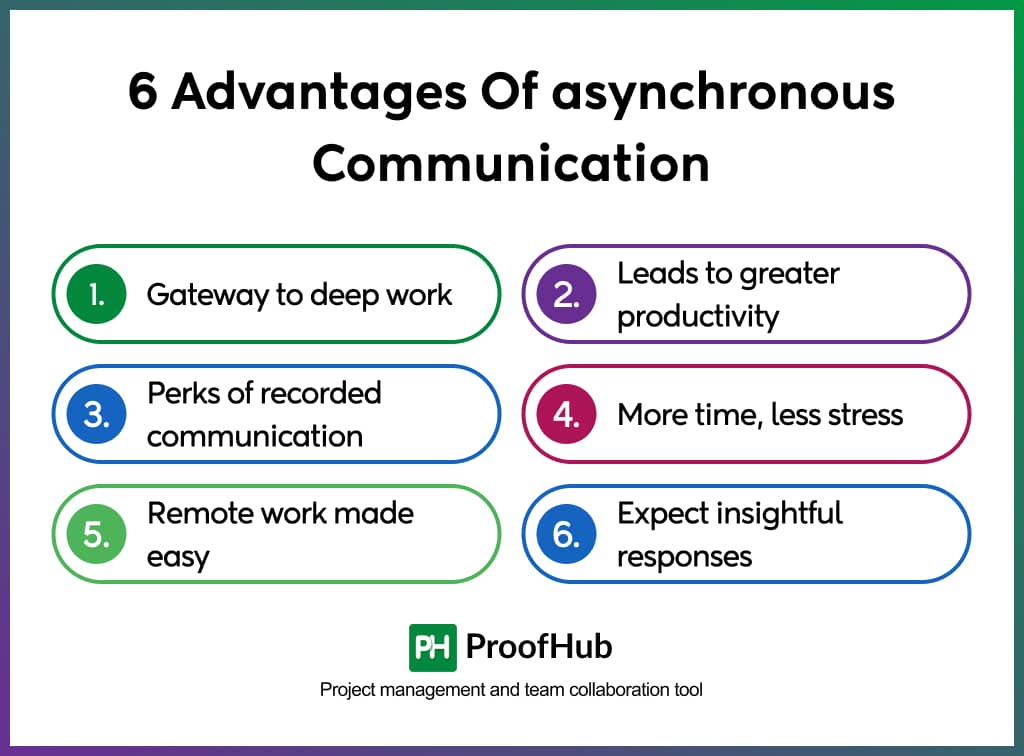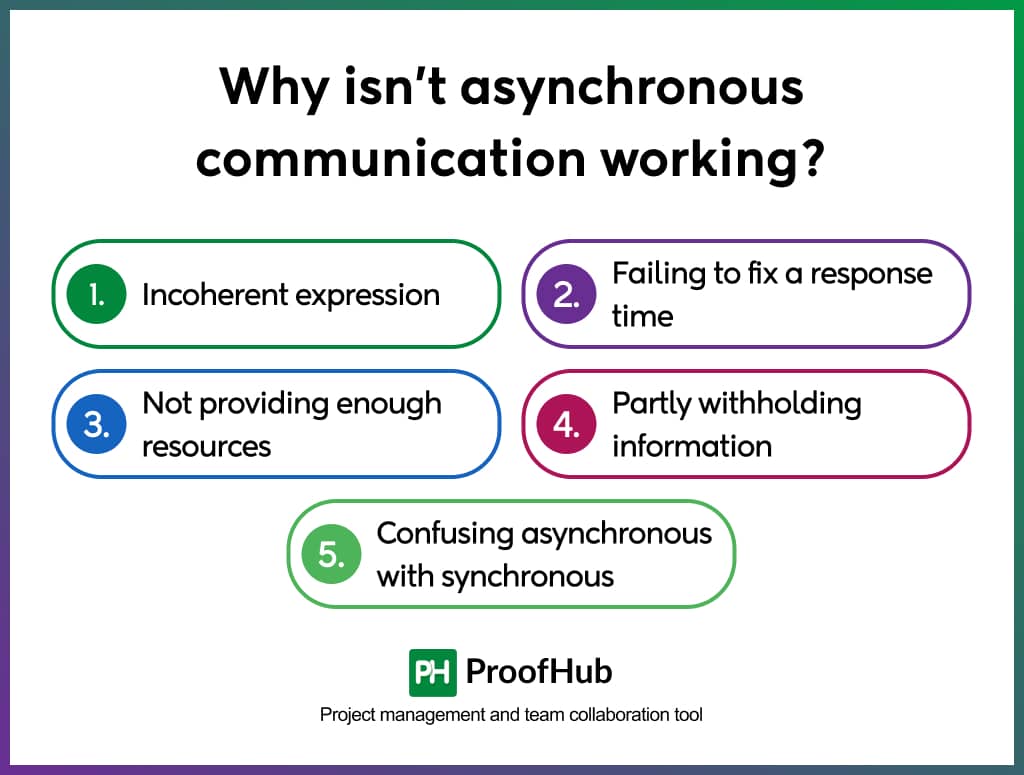Asynchronous communication an important part of team collaboration. Unlike real-time conversations, asynchronous communication allows you to send and receive messages on your own schedule. It is ideal for distributed teams for making workflows flexible.
Unlike synchronous communication, where interactions happen in real time asynchronous communication allows individuals to respond at their own pace. This approach helps reduce the pressure of immediate replies and enables better time management.
This article explores what asynchronous communication is, its key benefits, common challenges, and the best tools to help teams implement it effectively.
What is Asynchronous communication?
Asynchronous communication is any form of communication that doesn’t require an immediate response, and participants can engage at their convenience.
We communicate in an asynchronous way almost every day. We actually use it in various forms as well. Asynchronous communication can be seen taking place everywhere, ranging from a simple file transfer to sending out a pre-recorded video message.
When the real-time communication with your team, through meetings, feedback discussions, or brainstorming sessions has been loud and clear, you can carry out the tasks just as they are discussed. And, after a while, you might reach out to the people from your team with doubts or requests for reviews, and yet, not expect them to revert back right away.
When to use asynchronous communication?
Asynchronous communication should be used when you need detailed information, document the conversation, teams working in different time zones and require flexibility. Here is what you should know in detail:
- For detailed information: Whenever you are about to share detailed information or a complex report, asynchronous communication comes in handy to write or review the information at their own pace and reply.
- Documenting the conversation: Asynchronous communication is the best way when you want to document a conversation so that you can use it for future reference. So whenever you need a documented conversation, use asynchronous communication.
- When your team is across different time zones: When you have a team that is spread across the globe and has different time zones, asynchronous communication is the key to communicating effectively without everyone being online simultaneously.
- For flexibility: An asynchronous way of communicating gives your team members flexibility to respond when they have clarity about the matter at hand. So you should use asynchronous communication when you need a clear and thoughtful response without being concerned about the timeframe of the reply.
What are the benefits of asynchronous communication?

The communications taking place in the professional world are tipping heavily on asynchronous communication scales. This is because it works well for virtual teams, office-bound teams, and hybrid teams alike and here’s why:
1. Helps in deep work
Asynchronous communication can secure you a level of deep work as it does not interfere with or disrupt your day-to-day activities. Since nothing is asked of you urgently, you get to give your undivided attention to the task.
Distractions are majorly caused by unexpected calls, and instant messages, which mainly fall into the category of synchronous communication. Since these means of communication can potentially disrupt the way you work, asynchronous communication is the go-to way to conduct deep work.
2. Increases productivity
Since there are limited distractions with this communication, people set aside time to correspond to messages and address issues, this makes their work-time all the more productive and fruitful.
Another cause for this heightened productivity is that asynchronous communication helps teams make their planning process more efficient. Since people are not dependent on instant answers and quick feedback, plans can be laid down in an easier, more effective manner.
All of this leads to a highly motivated and productive work environment which can help you achieve a lot more with a lot less. Another noticeable benefit of this type of communication for the team is that it helps you document ideas, important information, and much more just the way in which it happens.
3. Facilitates ducumenting communication
Coming back to the point about documenting conversations, yes, asynchronous communication does help you keep a record of shared ideas, shared documents. It can virtually help you create a detailed wiki for the whole team/organization in the future.
This communication style can also help you maintain a standardized level of transparency. It will allow you space where you can readily make everyone aware of a particular change and ensure everyone is informed in a timely manner. For example, sending out a mass email to the whole company about an important policy change. This helps keep everyone informed, and on the same page at the very same time.
Needless to say, the methods of asynchronous communication make for an incredible contender for all the ways in which a team can keep records. Whether one is using a chatting tool, or collaboration software, your shared information is more than likely to be archived and, consequently, stay secure in the records.
4. Reduces distraction and stress
Asynchronous communication can relieve the stress on teammates caused by the instant demand for answers. Along with helping you work with a clear head, it also helps ensure communication that can be done entirely stress-free. Hence, this kind of communication is sure to be effective, and the outcomes are sure to be fruitful.
To summarize, this point states that:
- Asynchronous communication forms a gateway to effective collaboration and better decision-making that gives great results.
- It relieves the stress of catering to distractions that come in the form of unexpected questions and untimely messages.
5. Supports remote work and hybrid teams
Asynchronous communication is a savior for teams that are working in a hybrid environment or remotely from different time zones across the globe. This kind of communication actively helps teams collaborate, gather ideas, and work together as it doesn’t require real-time coordination.
6. Encourages thoughtful responses
Asynchronous communication allows you or your team member to take the time and come up with a thoughtful answer, which leads to effective communication.
If asynchronous communication is compared to in-person discussions, you will find that this communication gives you an opportunity to get a deeper understanding of the discussion you are expected to participate in.
Having trouble keeping your remote team on the same page? Try ProofHub for FREE and experience effortless Management.
What are the challenges with asynchronous communication?
- Delayed response: In asynchronous communication, as the responses are not immediate, it slows down the decision-making, progress of the project, and resolution to a problem. To overcome this challenge, you should set response time expectations for different types of communication channels.
- Misunderstanding: With the delayed response, a written communication can be misunderstood and require further explanation. Providing context in the messages, using emojis, and using clear, structured writing can help to overcome this challenge.
- Lack of social interaction: Without face-to-face interaction and real-time communication, a feeling of isolation arises. This also leads to a lack of trust among the team members. Encouraging non-work-related communication and scheduling virtual team bonding activities can help to fight against this challenge.
- Information overload: Multiple communication tools can lead to multiple stacks of messages, making it difficult for the team members to focus on important tasks. Using a single communication tool will help you overcome this challenge.
- Difficulty in tracking progress: When the information is spread over different tools, it is difficult to track the progress of any task or project. You can miss deadlines or fail to update progress with the scattered information. You can easily overcome this challenge by using a proper project management and collaboration tool, which will help you to track and communicate effectively.
Reasons why asynchronous communication might not be working for you
Since asynchronous communication is advantageous in so many ways, why does it still fail to suit us or benefit us at times? I have five ideas as to why:

1. Incoherent expression
While using asynchronous communication, both the sender and receiver require in-depth intel and interpretation. So, to make the communication more effective, you need to provide coherent and detailed information with context from the past conversation. If you fail to do so, the asynchronous communication won’t work for you.
2. Failing to fix a response time
The second reason why asynchronous communication is not working for you could be that you are not defining a response time expectation. If you are sending a message without providing a deadline to revert, then the receiver of the message might not respond according to your expectations.
3. Not providing enough resources
Now that the sender feels that they are likely to get an answer in a reasonable timeframe, and they are going to clarify their issues in detail, they are likely to expect a very straightforward yet comprehensive response.
But this isn’t always the case. If the recipient fails to respond with a detailed account as a response to their message, it is going to make your attempted asynchronous communication a potential failure.
4. Partly withholding Information
Asynchronous communication works best with a free flow of information, knowledge, and resources. If the recipient has any doubts about the information, they are free to share, but they must follow up with their superiors for that kind of additional guidance. Thus, the key to acing this one might be to have a solid chain of command.
5. Confusing asynchronous with synchronous
Since we set a time limit on how long a person can take in responding to an asynchronous message, there might also be a need to monitor the minimum amount of time in which your team is responding to these messages.
Because you see, If people are perceiving these messages as high-priority, they are likely to revert back as soon as they possibly can. The key to solving this problem might be to define different communication channels that pertain to these 2 different kinds of communication.
How to improve asynchronous communication?
Improving asynchronous communication can enhance productivity, collaboration, and efficiency. So, here are some tips to improve asynchronous communication:
1. Response time expectation: You should clearly define the timeframe by which you require the response. The receiver might not realize the message’s urgency without specifying the response time expectation.
2. Define “always off” time: Encourage your team members to take breaks and unplug from work without any pressure to respond immediately, especially outside working hours.
3. Use the right tool: It is important to use the right tool as per the urgency and nature of the message. You can use project management, collaboration, and instant messaging tools. It will help the team members to find the information and collaborate effectively.
4. Clarity and context: When you communicate asynchronously, you need to write a clear message about the problem you are facing with as much background detail as possible to make the context clear.
5. Use more than text: Sometimes it is tedious with only text messages, so you can come up with video meetings or screenshots in messages to enhance communication.
6. Create a communication plan: It is essential to create a communication plan that dictates when to use an asynchronous or synchronous way of communication. A communication plan helps you to decide which communication tool to use and when.
7. Encourage feedback: Asynchronous communication can cause misunderstandings because there is no real-time communication. So it is important to gather feedback and make adjustments as needed.
What are the type of communication tools?
You can use multiple tools to make your asynchronous communication effective. Different tools serve different purposes and make everyone comfortable accessing the right tools.
For instance, there are:

1. Online Collaboration Software
There are various types of collaboration platforms available that can help you and your team members stay in contact for achieving collective goals together. These tools also help unite the whole team on a platform where information can be built, added, modified, and shared.
Some examples of online collaboration software are: ProofHub, Asana, and Slack.
2. Documentation & editing tools
Documentation and editing tools are essential for asynchronous communication as they offer a structured and collaborative way to share, review, and re-work the information over time. In a hybrid or remote work environment, these tools ensure that every team member can access the same information regardless of their online time.
Notion, Google Docs, and Evernote are examples of documentation and editing tools.
3. Project management tools
With the use of the right project management tool, you can keep all your team members on the same page by providing each one of them with clarity of their tasks and responsibilities. All the communication that happens on these tools is asynchronous.
ProofHub, Monday.com, ClickUp, and Trello are examples of project management tools.
4. Video communication tools
Video tools allow you to record your message and send it to your team members so that they can watch it at their convenience. Not only this, but it also helps reduce the need for frequent meetings. Video tools are ideal for training and detailed project discussion and can be re-watched if needed.
Clickmeeting, Google Meet, Loom, and Zoom are great examples of video tools for asynchronous communication.
5. Note-sharing software
Note sharing software helps in asynchronous communication by allowing all team members to take and share important notes, ensuring everyone has access to the information without needing real-time feedback. Note sharing software also acts as the central hub for important information and documents.
ProofHub, Microsoft OneNote, and Zoho Writer are top examples of such note-sharing software.
What are the examples of asynchronous communication?
Here are some examples of asynchronous communication:
1. Email: Email is one of the most preferred sources of communication for formal communication and non-urgent discussions in the workplace, which hardly requires real-time response. This makes it one of the best examples of asynchronous communication.
2. Pre-recorded videos or presentations: Recorded videos of important meetings or presentations are also an example of asynchronous communication where the employees can watch them anytime and provide feedback in the future.
3. Wikis or knowledge base: Documents related to company policies are very important and can be required by the employees at different times. Knowledge base or wikis act as a central hub, and employees can access these important documents whenever they need them without asking repetitive questions.
4. Project management tools: Using project management tools, you can leave comments on any task or project, and your team members can respond to them whenever they can work on that task or project, making it another great example of asynchronous communication.
5. Discussion Forums: Discussion forums don’t require immediate response and demonstrate asynchronous communication. Reddit and Quora are examples of discussion forums where you can comment on different topics at your convenience.
We use this method of team communication almost constantly, and still, fail to see its value. So let’s go over:
What is Synchronous communication?
Synchronous communication is the real-time communication, where all participants are engaged at the same moment. It requires immediate responses and active participation from everyone involved. Common examples include in-person meetings, chat, or video conferencing.
It is useful for quick decision-making, brainstorming sessions, or discussions that require instant feedback.
What is difference between synchronous and asynchronous communication?
The main difference between synchronous and asynchronous communication is synchronous communication happens in real time, whereas, Asynchronous communication occurs without the need for immediate responses.
Here is a comparison table that tells you how synchronous communication is different from asynchronous:
| Features | Synchronous Communication | Asynchronous Communication |
| Definition | A form of communication that happens in real-time | A form of communication that happens over a delayed period without the need for immediate response |
| Response Time | Real-time or instant | Delayed (may be in hours or days) |
| Availability of Participants | All participants must be present at the same time | Participants engage at their convenience |
| Interruptions | An immediate response is required, so the chances of interruption are very high | Instant responses are not necessary, so the chances of interruption are very low |
| Best for | Urgent collaboration and quick decision making | Discussion across different time zones and flexibility |
| Workplace Examples | Team meetings, brainstorming sessions, and feedback discussions | Emails, forum discussions, and recorded presentations |
Give better feedback and make real progress with ProofHub. Try now for FREE.
Which one is better: Synchronous or asynchronous communication?
There is no clear winner here as both are better. It depends on the need of communication at a specific time, whether you need a real-time response or a delayed yet thoughtful response.
The takeaway
Asynchronous communication is not just a trend but a way of communication that streamlines workflow, reduces interruptions, enhances productivity, and fosters a culture of seamless collaboration.
By utilizing the proper tools and setting the best strategies, teams spread across the globe can evolve into a more productive and innovative unit. Asynchronous communication mitigates stress and helps remote & hybrid teams thrive by focusing on the task and being flexible to respond whenever convenient.

